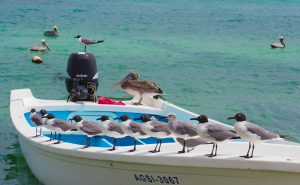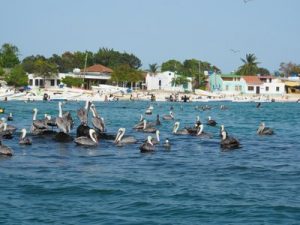Venezuela: A cruiser’s experience in the Gran Roques archipelago
S/Y Crocodile recently visited the Gran Roques archipelago and sent Noonsite a record of their experiences
Published 7 years ago, updated 6 years ago


We arrived in front of El Gran Roque at position 11°56′55″N, 66°51′08″W. The holding is good, depths decrease to approximately 2.5m in a reasonable distance to the shore. It can be rolly
The description of the clearing in the process in Noonsite is most valuable and you are lost without it. You can do it yourself (no agent), and it takes approximately three hours and some walking; however, you need Bolivars before you start.
Most important: before you start you need Bolivars and plenty of them. Ask for big notes and bring a rucksack or two (since US$ are not accepted as a payment).
There is a pharmacy in the centre of the village where you can change. It is open approximately after 5 pm. The word “gambio” is understood by locals and they will give you directions. This is somewhat illegal; however, the only way accepted by everybody, even the officials. The cash machine at the local bank does not give you Bolivars. When we tried to do it at the bank counter, there was a line of some 20 locals in front of us for whatever reason. The black market exchange rate is presently approx. 6500 Bolivars for US$1. We paid a mere 10,000 Bolivars at immigration and 495,000 Bolivars for the marine park (we are on a 40-foot catamaran with two people).
We could pay in US$ in bodegas and the supermarket and got US$ back. Bring small notes, the US$100 notes we have had are too big.
English is not spoken and without knowledge of Spanish communication is very difficult.
Inflation in Venezuela is around 700% in 2017. This has an impact and doesn’t be surprised if asked for money by officials. If you can, give something: these are people in need.
All the people we have met were most friendly and helpful, we never felt in any way endangered or threatened.
There is no internet and surprisingly there is no booklet or a map of the archipelago to be found at the local stores. Also, fuel is hard to get by, except somewhat illegal with the help from locals.


We highly recommend Bodega Tsunami in El Gran Roque: the charming hostess speaks very good English, the food is excellent and not expensive.
We also highly recommend the island Crasqui (11°52′76″N, 66°44′01″W) and Carolas Restaurant there: simple, good food, charming hostess, lovely kids and very kind dogs.
Eyeball navigation is absolutely necessary. The electronic chart we have used (Garmin) is often surprisingly accurate; however, we have found on several occasions that we might have run aground without a proper lookout.
A beautiful and peaceful place to drop the hook is Carenero (11°52′93″N, 66°50′98″W). The archipelago is absolutely quiet. Quite often we were the only yacht in an anchorage.
When we arrived end of June the place was overflowing with hundreds of pelicans and seagulls. We very much liked it and have never seen something like this before. When we returned two weeks later all the birds were gone, with a few exceptions. This is an annual happening and if you are a bird lover it would be worthwhile to study the migration patterns of birds in this region, most likely linked to the seasonal fish populations.
This place is absolutely worth visiting and we do not understand why somebody might want to convey a bad impression of it.
Kind regards,
Erwin Pönitz & Ingrid Schindler, SY Crocodile, Bonaire
Related content
Related to following destinations: Los Roques, Venezuela




